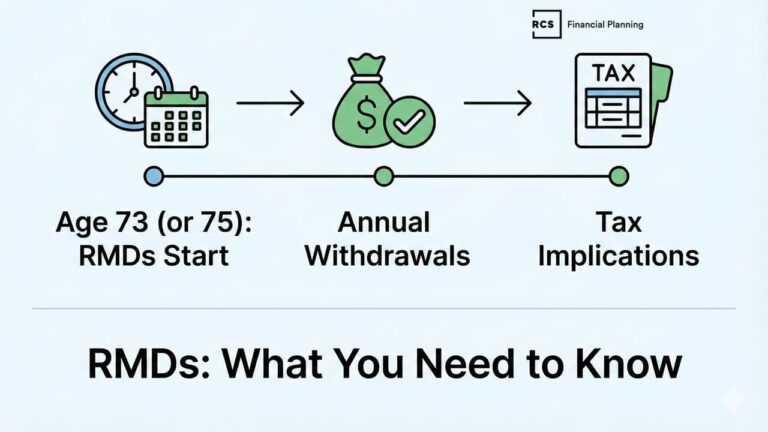What Is the Widow Penalty? How Tax Changes Can Impact Surviving Spouses
Introduction
Losing a spouse brings emotional grief that’s difficult to put into words. But there’s also a financial reality that catches most couples unprepared: the widow penalty.
This isn’t an official tax or fee. It’s the combination of reduced income and increased taxes that strikes when a surviving spouse must transition from “married filing jointly” to “single” tax status.
The numbers tell a concerning story: Many surviving spouses see their household income drop by 25-50%, yet find themselves paying higher tax rates on what remains. Medicare premiums can spike by thousands of dollars. And Social Security income that once supported two people must now sustain one.
In our work with pre-retirees and retirees over the past two decades, we’ve seen this pattern repeatedly. The widow penalty is predictable, and with proper planning, much of its impact can be reduced.
This guide will help you understand exactly what happens financially when one spouse passes away, and more importantly, what you can do now to protect your family’s financial security.
What Happens Financially When One Spouse Dies
The term “widow penalty” describes three simultaneous financial changes that affect surviving spouses:
1. Income Reduction
When one spouse passes away, household income typically drops by 25-50%. Here’s why:
Social Security: You don’t keep both benefits. The surviving spouse receives only the higher of the two monthly amounts. For a couple receiving $4,200 monthly ($2,500 + $1,700), this becomes just $2,500—a 40% decrease in Social Security income.
Pensions: Many pension plans reduce payments or stop entirely after the pensioner’s death, depending on the survivor benefit option selected at retirement.
Investment income: If retirement accounts or investment portfolios were held primarily in one spouse’s name, access and income patterns may shift.
2. Higher Tax Rates on Lower Income
This is where the mathematics become particularly challenging:
Tax bracket compression: Single filers face the same tax rates as married couples, but at half the income levels. In 2026, the 22% tax bracket begins at $50,400 for singles versus $100,800 for married couples filing jointly.
Reduced standard deduction: The standard deduction for married couples filing jointly, 65 and older, is $35,500 (2026), but drops to $18,150 for single filers.
Social Security taxation: For married couples, up to 85% of Social Security becomes taxable when combined income exceeds $44,000. For single filers, this threshold drops to $34,000—making more of the benefit taxable at lower income levels.
3. Medicare Premium Increases (IRMAA)
Income-Related Monthly Adjustment Amounts (IRMAA) add Medicare Part B and Part D surcharges when income exceeds certain thresholds.
The thresholds differ dramatically by filing status:
- Married filing jointly: IRMAA surcharges begin at $218,000 (2026)
- Single filers: Surcharges start at just $109,000
A widow with an unchanged income could suddenly pay over $6,500 annually in Medicare premiums.
A Real-World Example: Understanding the Numbers
Let’s look at a composite example based on patterns we’ve observed with clients:
While Both Spouses Are Living:
- Combined income: $140,000 ($85,000 from retirement accounts, $55,000 from Social Security)
- Tax filing status: Married filing jointly
- Tax bracket: 12%
- Standard deduction: $35,500
- Enhanced Senior Deduction: $12,000
- Maryland Senior Credit: $1,750
- Federal taxes: Approximately $7,400
- Medicare premiums: Standard ($202.90/month per person in 2026)
After One Spouse Passes Away:
- Survivor income: $105,000 ($85,000 from retirement accounts, $20,000 from Social Security—keeping only the higher benefit)
- Tax filing status: Single (after the year of death)
- Tax bracket: 22%
- Standard deduction: $18,150
- Enhanced Senior Deduction: $4,380
- Maryland Senior Credit: $0
- Federal taxes: Approximately $11,500
- Medicare premiums: Standard
The Result: Despite a 25% reduction in household income ($35,000 less), the widow pays approximately $4,000 more in federal taxes annually.
This pattern repeats across different income levels. The specific numbers vary, but the core dynamic remains: less income, higher tax rates.
Not sure if you’re missing anything in your retirement plan?
These 3 free checklists cover retirement planning, tax strategies, and important financial deadlines—so you can make informed decisions with confidence.
Why Most Couples Don’t Plan for This
In our conversations with hundreds of couples, we’ve identified several reasons why the widow penalty catches people off guard:
1. It feels morbid to discuss. Many couples avoid detailed “what if” conversations about death, preferring to focus on enjoying retirement together.
2. Advisors don’t always bring it up. Not all financial professionals proactively model the survivor’s financial situation or discuss tax-efficient strategies to address it.
3. It seems distant. When both spouses are healthy, planning for survivorship feels less urgent than other retirement priorities.
4. The tax code complexity is intimidating. Understanding how different tax rules interact requires walking through specific scenarios, which feels overwhelming.
Yet the widow penalty affects nearly every married couple at some point. And the strategies to reduce its impact work best when implemented years before they’re needed.
Seven Evidence-Based Strategies to Reduce the Widow Penalty
Based on our experience helping clients navigate this challenge, here are the most effective planning strategies:
Strategy 1: Optimize Social Security Timing for Survivor Benefits
The higher-earning spouse’s claiming decision has lasting implications for the surviving spouse.
Key consideration: Delaying Social Security increases the monthly benefit amount, and this higher benefit transfers to the surviving spouse. However, delaying isn’t always optimal—it depends on your specific health, longevity expectations, and other income sources.
Example from our practice: We worked with a couple where the husband’s benefit at age 70 would be $3,200 monthly versus $2,400 at age 67. By evaluating their overall financial situation and health factors, we determined that delaying made sense in their case. This decision ensures his wife receives $800 more monthly if he predeceases her—adding up to nearly $10,000 annually for the rest of her life.
What to evaluate:
- Both spouses’ health and family longevity patterns
- Other income sources available to delay claiming
- The permanent impact on survivor benefits
- Break-even analysis specific to your situation
Strategy 2: Create Tax Diversification Across Account Types
Having retirement savings in different tax treatments gives the surviving spouse flexibility to manage their tax situation.
The three tax buckets:
- Tax-deferred (Traditional 401(k), IRA): Withdrawals taxed as ordinary income
- Tax-free (Roth 401(k), Roth IRA): Qualified withdrawals are tax-free
- Taxable (Brokerage accounts): Capital gains taxed at preferential rates, plus step-up in basis at death
Why this matters: A widow with all savings in traditional IRAs must take Required Minimum Distributions (RMDs) that push them into higher tax brackets. But a widow with tax diversification can choose which accounts to draw from based on their current tax situation.
Strategy 3: Execute Strategic Roth Conversions While Married
Converting traditional retirement funds to Roth IRAs while married offers several advantages:
The married tax bracket benefit: Married couples can convert more dollars before reaching higher tax brackets. This allows you to “prepay” taxes at lower rates, creating tax-free income for the surviving spouse.
Reducing future RMDs: Money converted to Roth accounts doesn’t have required minimum distributions during the owner’s lifetime. This gives the survivor more control over their taxable income.
The planning approach we use: Rather than converting everything at once, we typically model converting amounts annually that “fill up” the 12% or 22% tax bracket while married, avoiding the higher rates the surviving spouse would face alone.
What it looks like: A couple converting $40,000 annually from traditional to Roth accounts while in the 22% tax bracket pays $8,800 in taxes. This same widow, withdrawing that money later as a single filer, might pay 24% or 32%—significantly more over time.
Strategy 4: Leverage Qualified Charitable Distributions (QCDs)
If you’re over 70½ and charitably inclined, QCDs offer a tax-efficient way to reduce taxable income.
How it works:
- Donate up to $108,000 annually directly from your IRA to qualified charities
- The donation counts toward your Required Minimum Distribution
- The amount doesn’t appear as taxable income
Widow penalty benefit: This strategy lowers the surviving spouse’s adjusted gross income, which can help them:
- Stay in lower tax brackets
- Reduce Social Security taxation
- Avoid or minimize Medicare IRMAA surcharges
Strategy 5: Implement Tax-Efficient Asset Location
Where you hold different types of investments matters for taxes.
Asset location framework:
- Roth accounts: High-growth investments that benefit from tax-free compounding
- Tax-deferred accounts: Tax-inefficient investments like bonds or REITs
- Taxable accounts: Tax-efficient investments that benefit from capital gains treatment and step-up in basis
The step-up advantage: Assets held in taxable accounts receive a “stepped-up basis” at death, potentially eliminating capital gains taxes for the surviving spouse. This makes taxable accounts particularly valuable for highly appreciated assets.
Strategy 6: Plan Around Medicare IRMAA Thresholds
Income management becomes more important when one spouse faces Medicare IRMAA surcharges alone.
Proactive strategies:
- Model your expected income in Medicare years
- Time Roth conversions before Medicare eligibility or during low-income years
- Coordinate withdrawals to stay below IRMAA thresholds when feasible
- Understand the 2-year lookback (2026 IRMAA based on 2024 income)
When threshold management isn’t possible: If your income will exceed IRMAA thresholds regardless, focus on the other strategies to maximize tax efficiency overall.
Strategy 7: Prepare Your Spouse for Financial Transition
Beyond tax strategies, ensuring your spouse can navigate financial decisions during grief is essential.
What this includes:
- Comprehensive document with all accounts, contacts, and passwords
- Introduction to your financial advisor (if applicable)
- Clear instructions for immediate financial steps after death
- Regular check-ins so both spouses understand the financial picture
From our experience: The surviving spouses who handle the transition most effectively are those who were already familiar with their financial situation and had clear guidance prepared in advance.
Common Planning Mistakes to Avoid
Mistake #1: “We’re Wealthy Enough That Taxes Don’t Matter”
Higher net worth actually increases widow penalty vulnerability. Larger retirement account balances mean larger RMDs, which push surviving spouses into higher brackets and IRMAA surcharges more easily.
Mistake #2: Not Coordinating Social Security Timing
Claiming Social Security at 62 might make sense for the lower-earning spouse, but it rarely makes sense for the higher earner whose benefit becomes the survivor benefit. This single decision can cost the surviving spouse $100,000+ over their lifetime.
Mistake #3: All Retirement Savings in Traditional Tax-Deferred Accounts
Without Roth accounts or taxable accounts, the surviving spouse has no flexibility to manage their tax situation. They’re forced to take RMDs that push them into higher brackets.
Mistake #4: Waiting Too Long to Plan
The best widow penalty strategies work over years or decades. Roth conversions, for example, work best when spread across multiple years in lower tax brackets—not executed in a rush when health declines.
Assessing Your Widow Penalty Risk
Here’s how to evaluate your specific situation:
Step 1: Project Your Survivor’s Income
Calculate:
- Which Social Security benefit would continue (the higher amount)
- Pension survivor benefits (if applicable)
- Income from retirement accounts and investments
- Any other income sources
Total these amounts to understand the survivor’s expected income.
Step 2: Compare Tax Situations
Using your survivor income number:
- Determine which tax bracket they’d fall into as a single filer
- Compare this to your current bracket as a married couple
- Calculate the approximate tax difference
Step 3: Check Medicare IRMAA Exposure
If your survivor’s income would exceed $109,000 (2026 threshold for singles), factor in Medicare surcharges that could add $1,000-$6,000+ annually.
Step 4: Identify Account Tax Diversification
Review what percentage of your retirement savings is in:
- Tax-deferred accounts (Traditional IRA, 401(k))
- Tax-free accounts (Roth IRA, Roth 401(k))
- Taxable accounts
Ideal position: Meaningful balances in all three account types, giving the survivor flexibility.
Taking Action: Your Next Steps
The widow penalty is significant, but it’s also largely preventable with proper planning.
Three Things You Can Do This Week:
- Run a survivor income projection. Calculate what your household income would look like if either spouse passed away today. This exercise alone reveals whether you face widow penalty risk.
- Review your Social Security claiming strategy. If the higher-earning spouse hasn’t claimed yet, model the survivor benefit impact of different claiming ages.
- Assess your retirement account tax diversification. If everything is in traditional tax-deferred accounts, start researching Roth conversion strategies.
When Professional Guidance Makes Sense
Widow penalty planning involves multiple moving parts: Social Security optimization, multi-year tax projections, Roth conversion modeling, and Medicare planning. These pieces need to work together as part of your overall retirement income strategy.
If you’d like a second set of eyes on your situation, we offer a complimentary widow penalty assessment for couples approaching retirement. We’ll:
- Calculate your specific widow penalty exposure
- Model different Social Security claiming scenarios
- Identify Roth conversion opportunities
- Create a timeline for implementation
About Ted Toal, CFP®: Ted Toal is a Certified Financial Planner™ and founder of RCS Financial Planning in Annapolis, Maryland. Ted specializes in tax-efficient retirement income planning for couples with $1M+ in invested assets, with particular expertise in widow penalty mitigation, Social Security optimization, and Medicare planning. Over 25 years, he’s helped hundreds of families navigate the financial complexities of retirement while protecting their long-term security.
Questions About Your Retirement?
Whether you’re planning for retirement or already there, we’re here to help. What questions can we answer?
We respect your privacy. We will never sell or share your information with any third party. You can unsubscribe at any time with just one click.
This material is provided for educational, general information, and illustration purposes only. You should always consult a financial, tax, or legal professional familiar with your unique circumstances before making any financial decisions. Nothing contained in the material constitutes tax advice, a recommendation for the purchase or sale of any security, or investment advisory services. This content is published by an SEC-registered investment adviser (RIA) and is intended to comply with Rule 206(4)-1 under the Investment Advisers Act of 1940. No statement in this article should be construed as an offer to buy or sell any security or digital asset. Past performance is not indicative of future results.






